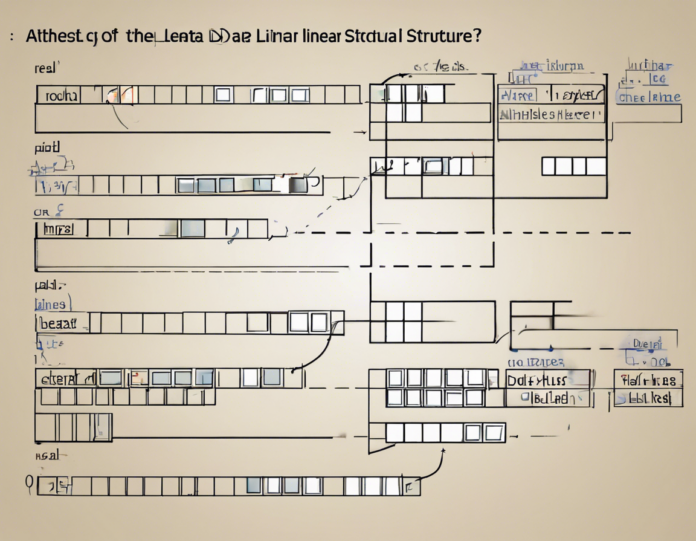Linear Data Structures Explained: Types and Examples
In computer science, data structures are a crucial aspect of organizing and managing data efficiently. They allow us to store and manipulate data in a way that makes operations more straightforward and optimized. One essential category of data structures is linear data structures, which are characterized by elements arranged in a sequential order. In this comprehensive guide, we will delve into the various types of linear data structures, their characteristics, and examples to provide a thorough understanding of their significance in programming and algorithm design.
1. Introduction to Linear Data Structures
Linear data structures are collections of data items where each item is connected to its previous and next item, forming a sequence. These structures are simple to implement and can be easily understood, making them fundamental in computer science and programming. Linear data structures are particularly useful when the order of data elements is critical. Operations such as insertion, deletion, traversal, and searching can be efficiently performed on linear data structures.
2. Types of Linear Data Structures
2.1. Arrays
Arrays are one of the most basic forms of linear data structures, consisting of a collection of items stored at contiguous memory locations. Each element in an array is accessed by its index, making retrieval and updating of elements efficient. However, arrays have a fixed size, which can lead to memory wastage if the size is larger than needed.
2.2. Linked Lists
Linked lists are dynamic data structures where elements, known as nodes, are linked together using pointers. Each node contains data and a reference to the next node in the sequence. Linked lists come in various forms, such as singly linked lists, doubly linked lists, and circular linked lists, offering flexibility in terms of operations and memory management.
2.3. Stacks
Stacks follow the Last In, First Out (LIFO) principle, where elements are inserted and removed from one end known as the top. Stacks support two primary operations, namely push (inserting an element onto the stack) and pop (removing the top element from the stack). This data structure is commonly used in function calls, expression evaluation, and backtracking algorithms.
2.4. Queues
Queues adhere to the First In, First Out (FIFO) principle, where elements are added at the rear end, known as enqueue, and removed from the front end, known as dequeue. Queues are essential in scenarios such as task scheduling, printer queues, and breadth-first search algorithms. Circular queues and priority queues are variations of the standard queue data structure.
2.5. Strings
While not often categorized as a traditional linear data structure, strings are sequences of characters that are stored sequentially in memory. Operations such as concatenation, substring extraction, and comparison are common string manipulations that showcase the linear nature of strings.
3. Examples of Linear Data Structures
3.1. Example of Arrays
“`python
Example of creating and accessing elements in an array in Python
arr = [10, 20, 30, 40, 50]
print(arr[2]) # Output: 30
“`
3.2. Example of Linked Lists
“`python
Example of creating a singly linked list in Python
class Node:
def init(self, data):
self.data = data
self.next = None
Create nodes
node1 = Node(10)
node2 = Node(20)
node3 = Node(30)
Link nodes
node1.next = node2
node2.next = node3
“`
3.3. Example of Stacks
“`python
Example of implementing a stack using Python list
stack = []
stack.append(10) # Push element onto the stack
stack.append(20)
print(stack.pop()) # Output: 20 (element popped from the stack)
“`
3.4. Example of Queues
“`python
Example of implementing a queue using collections.deque in Python
from collections import deque
queue = deque()
queue.append(10) # Enqueue element into the queue
queue.append(20)
print(queue.popleft()) # Output: 10 (element dequeued from the queue)
“`
4. Advantages of Linear Data Structures
-
Efficient Insertion and Deletion: Linear data structures offer quick insertion and deletion operations, especially in stacks and queues.
-
Easy Traversal: Traversing elements in a linear sequence simplifies operations such as searching and sorting.
-
Dynamic Memory Allocation: Structures like linked lists enable dynamic memory allocation, optimizing memory usage.
-
Flexibility: Different linear data structures cater to varied requirements, providing flexibility in implementing algorithms.
5. Frequently Asked Questions (FAQs)
Q1. What distinguishes linear data structures from nonlinear data structures?
Linear data structures maintain elements in a sequential order, allowing for easy traversal from one element to the next. In contrast, nonlinear data structures do not follow a sequential arrangement, making traversal more complex.
Q2. How are arrays different from linked lists?
Arrays have a fixed size allocated in memory, require contiguous storage, and offer constant-time access to elements by index. On the other hand, linked lists are dynamic in size, use non-contiguous memory, and provide efficient insertion and deletion operations.
Q3. How do stacks and queues differ in their operation?
Stacks operate on the Last In, First Out (LIFO) principle, where elements are added and removed from the same end. Queues, however, follow the First In, First Out (FIFO) principle, inserting elements at one end and removing them from the other end.
Q4. What are the applications of linear data structures in real-world scenarios?
Linear data structures find applications in various domains such as operating systems (task scheduling), web development (handling user requests), and artificial intelligence (search algorithms).
Q5. Can linear data structures be combined to enhance data manipulation capabilities?
Yes, combining linear data structures can lead to the development of more sophisticated data structures like graphs and trees, which are fundamental in advanced algorithms and data representation.
Conclusion
Understanding linear data structures is critical for mastering data organization and algorithm design. By grasping the concepts of arrays, linked lists, stacks, queues, and strings, programmers can efficiently manage and manipulate data in a logical and structured manner. Each linear data structure offers unique characteristics and advantages, making them indispensable tools in software development and problem-solving. Embracing the versatility of linear data structures equips programmers with the foundational knowledge required to tackle complex computational challenges effectively.









